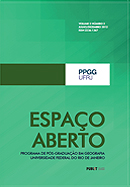Mapping Atmospheric Corrosion as a Heritage Management Tool in Oaxaca, Mexico
DOI:
https://doi.org/10.36403/espacoaberto.2019.28384Palabras clave:
Archaeometry, Heritage Conservation, Atmospheric Corrosion, Archaeometallurgy, Global WarmingResumen
Archaeometry is the application of Natural Sciences techniques, including Geography, to solve problems in Archaeology and Heritage Conservation. Corrosion constitutes the main deterioration process of metals, which is triggered by the properties of the surrounding matrix. This work focuses on atmospheric corrosion in Oaxaca, Mexico. Methods used included the creation of atmospheric corrosion stations where weight loss was measured and geo-localization of archaeo-metallurgical heritage was determined in the study area. A brief historical review of the cultural importance of metals in Mexico is also treated. Results for the three first months of measurement showed that atmospheric corrosion values are higher in the city centre, where heritage is more concentrated. Air pollution and increased temperatures attributed to global warming are considered to be relevant for explaining the data obtained. Further analysis of a full year cycle is expected to reinforce this argument. The methods used are shown to be useful heritage and urban management tools applicable to other geographic spaces.
Métricas
No metrics found.


